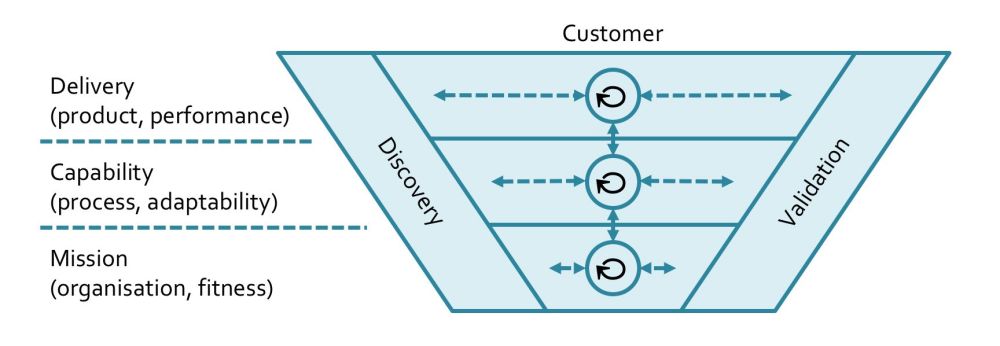The theory:

That’s right, the entire organisation supporting its customer-facing staff, the CEO at the bottom of the inverted pyramid. Intriguing!
Here’s my version, which you’ll find in chapter 5 of the latest revision of the Agendashift book (the last announced Leanpub revision before we go to print):

Key differences:
- Instead of the CEO and senior managers we have processes. No need to promote power hierarchies!
- It’s opinionated: each process begins with Discovery and ends with Validation. It’s both humbling and powerful – transformative, even – to acknowledge both that we don’t know everything, not least the eventual impact of our work.
- Review meetings of various unspecified kinds – service delivery reviews, capability reviews, strategy reviews, and risk reviews, even standup meetings and planning meetings
- Mutual accountabilities, horizontally and vertically
The lack of specificity in point 3 is deliberate: in Agile terms, we’re scaling, but we’re inviting a start with what you do now approach rather than insisting on a particular process framework. So how, exactly?
Here are three ways for you to look at your existing review meetings, three dimensions in which most such meetings can be improved:
- How might they be more outside-in (customer before organisation, platform, product, team, etc)? Who best represents each agenda item? In what order? Sharing what metrics (and implying what values)? What contradictions are we likely to find between these different perspectives, and are we prepared to deal with them?
- How might they be more right-to-left (recently-completed work first, then working backwards)? Do participants feel mutually accountable for an end-to-end process that focusses on outcomes and finishes with validation? What keeps those outcomes connected to authentic needs, and how are needs discovered and prioritised? What keeps workloads at appropriate levels?
- Horizontally and vertically, do your meetings together cover the organisation (or at least the part thereof that is the focus of your interest)? Horizontally, does each contributing part feel sufficiently connected, with overlapping participation across meetings? Vertically, is the organisation adequately represented so that delivery work, capability-related work, and mission can be kept in alignment?
The trick is to recognise that you don’t have to turn everything upside-down in one giant upheaval – the reorientation can start locally, and at any level. Locally doesn’t mean “timidly” though – in fact the way these strategies encourage accountability horizontally and vertically across organisational boundaries makes them both silo-busting and bubble-busting. Scary perhaps, but if you want to influence the rest of the organisation, then maybe you must be prepared to be influenced back…
More on this in my talk at London Lean Kanban Days 2018 (23-24 April) – see you there!
Upcoming Agendashift workshops (see Events ):
 Blog: Monthly roundups | Classic posts
Blog: Monthly roundups | Classic postsLinks: Home | About | Partners | Resources | Contact | Mike
Community: Slack | LinkedIn group | Twitter
